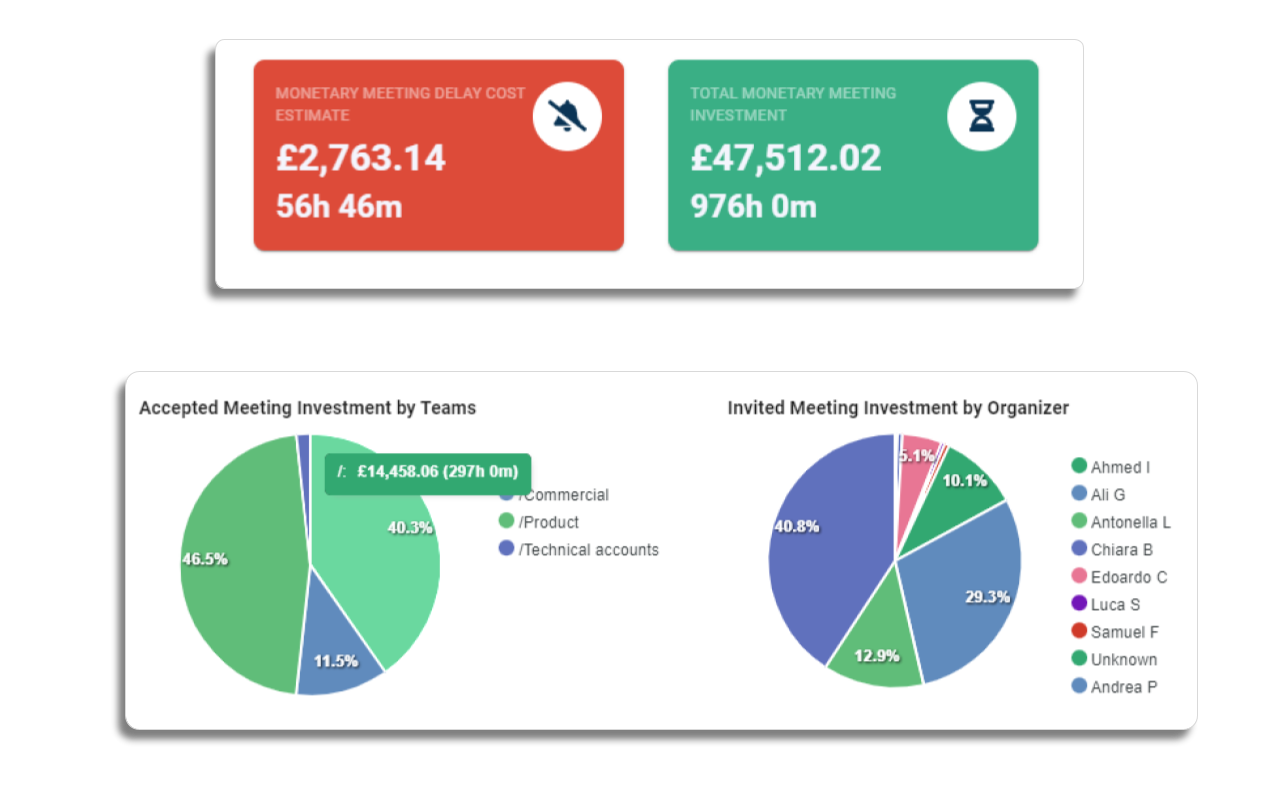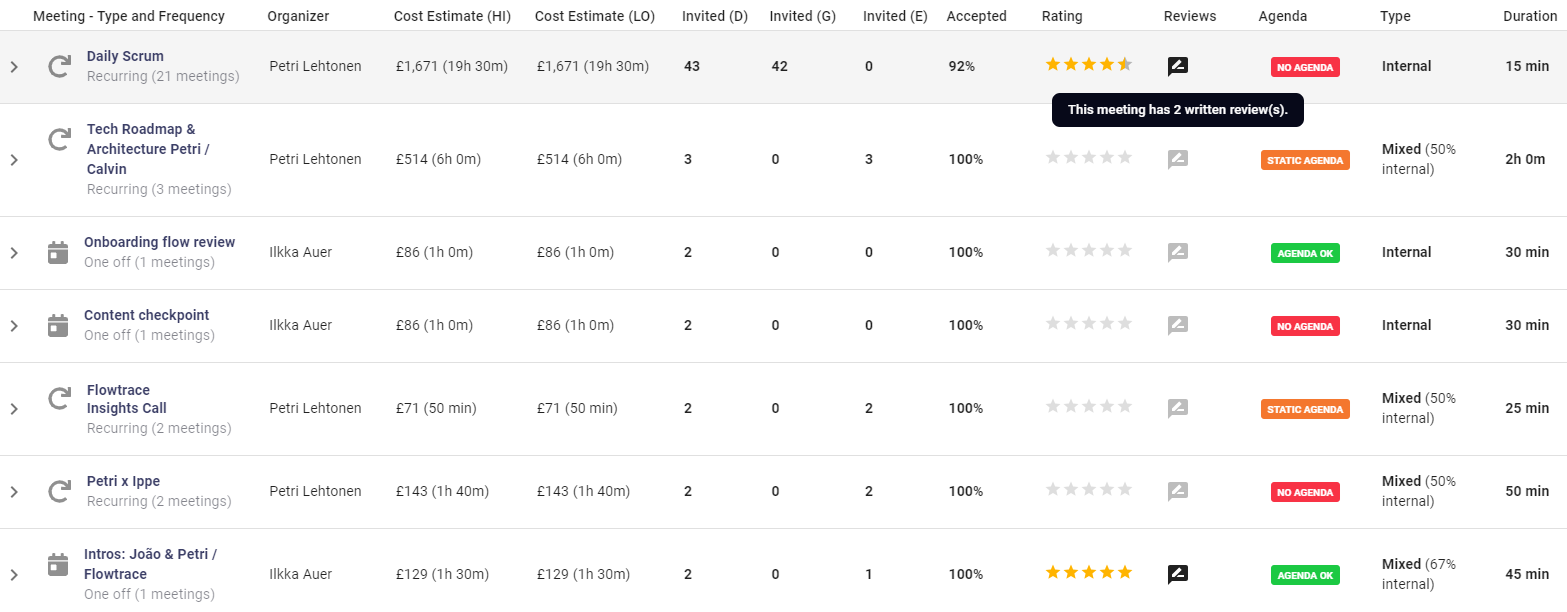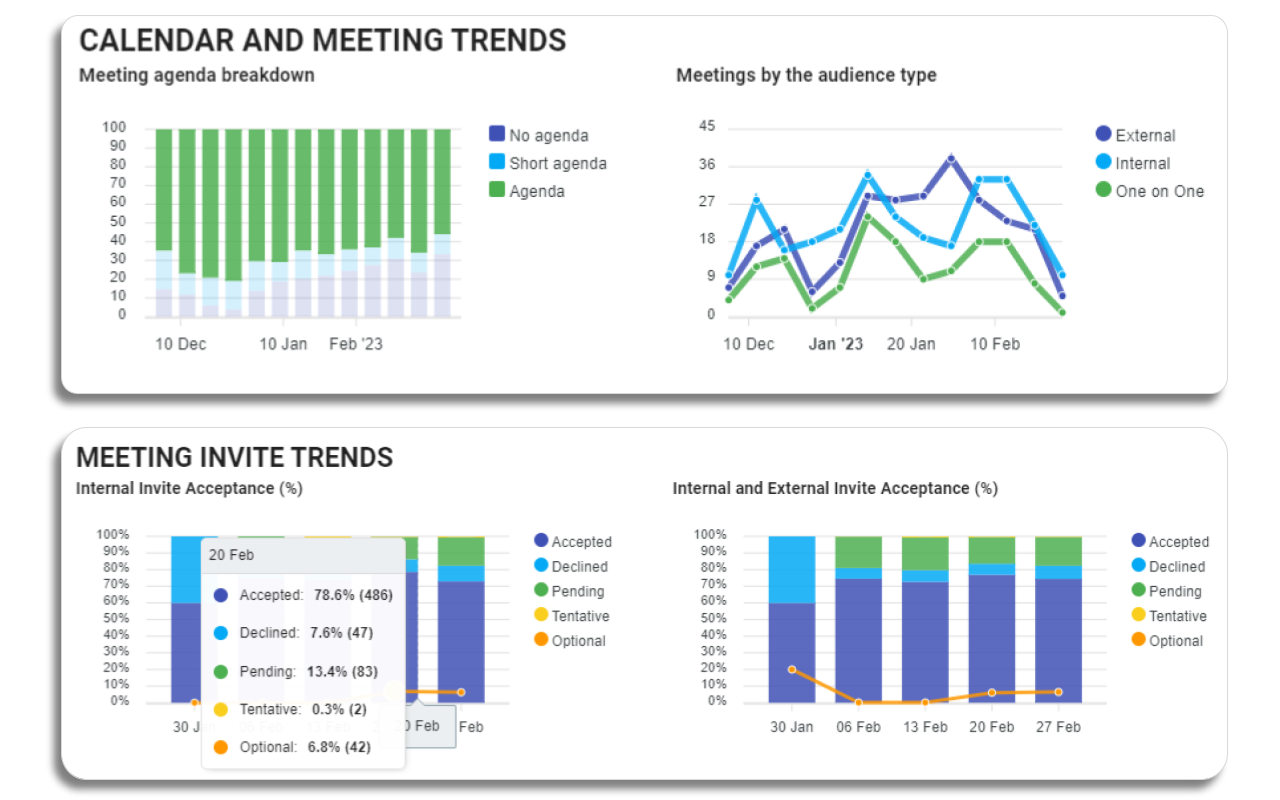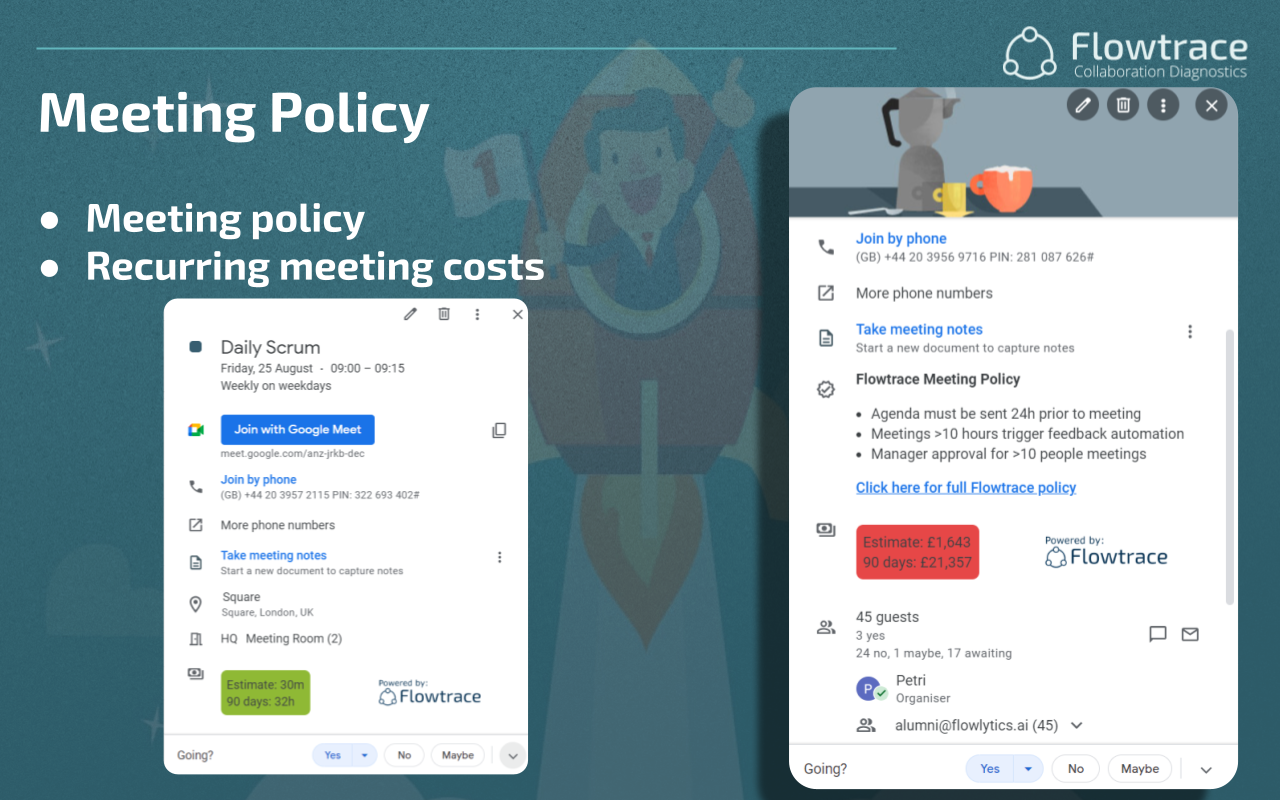Meeting Cost Plugins for Google & Outlook
Optimize meetings with these meeting cost plugins for Google Calendar and Microsoft Outlook. Gain real-time cost insights to schedule smarter and...
Explore cost-saving strategies for meetings, including conducting calendar audits, understanding meeting culture, implementing meeting analytics tools, and deploying cost management tools.
Meetings are a fundamental component of operations, supporting teamwork, decision-making, and organizational planning. Yet, despite their importance, meetings often come with substantial costs, both seen and unseen, which can impact a company’s resources and efficiency. As organizations strive to optimize their operational efficiencies and boost productivity, implementing cost-saving strategies for meetings has become imperative.
This article will explore various approaches to reducing the financial and resource burden of meetings. From leveraging advanced analytics to refine meeting schedules to adopting technology that enhances meeting effectiveness, we will delve into strategies that help organizations make the most of their meetings while keeping costs in check.
Meetings are essential for facilitating collaboration and decision-making within organizations. However, they also incur substantial costs that, if not carefully managed, can significantly impact an organization's resources. These meeting costs extend beyond the direct expenses of venue rentals or catering; they encompass significant indirect costs such as the opportunity cost of time that could be spent on other productive activities.
Studies indicate that there are substantial losses due to unproductive meeting practices. For instance, it is estimated that unproductive meetings cost U.S. businesses around $37 billion annually, reflecting the severe impact of inefficient meeting management on organizational resources.

Furthermore, another report highlights that workers spend an average of 31 hours each month in unproductive meetings, which translates into a considerable loss of productivity across the workforce.
Reducing the costs associated with meetings is essential for several reasons. Primarily, it directly enhances organizational efficiency by freeing up time and resources that can be better utilized towards achieving business goals. Efficiently managed meetings reduce redundancy, minimize time wastage, and ensure that every meeting delivers value, either in the form of direct decision-making or strategic alignment.
Adopting cost-effective meeting strategies is vital for maintaining operational efficiency and a competitive edge. Streamlined meetings reduce unnecessary expenditures and optimize time management, leading to improved productivity and employee satisfaction. Effective meeting management involves not only reducing the frequency and duration of meetings but also ensuring that each meeting is purpose-driven and results-oriented.
By prioritizing the reduction of meeting costs, organizations can achieve more focused and productive engagements. This approach not only conserves financial and human resources but also enhances the overall agility and responsiveness of the organization, enabling quicker adaptation to market changes and strategic pivots.
Let’s take a look at some strategies you can adopt:
A calendar audit is an essential step in understanding how meeting time is allocated within an organization. By thoroughly examining the calendars of employees, especially those in key roles, organizations can gain insights into the frequency, duration, and distribution of meetings. This analysis helps identify patterns and potential inefficiencies that might be overlooked during routine operations.
To conduct an effective calendar audit, organizations should:

The benefits of performing a calendar audit include:
After conducting a calendar audit, organizations should take actionable steps based on the findings. This might involve setting new guidelines for meeting frequency, duration, and participation. It could also lead to the adoption of new tools and technologies that support more efficient scheduling and communication, ensuring that meetings are a productive use of time rather than a cost burden.
By regularly auditing and adjusting meeting practices based on calendar data, organizations can significantly enhance productivity and reduce the indirect costs associated with poorly managed meetings. This approach ensures that meetings serve their intended purpose of advancing organizational goals effectively and efficiently.
Gaining an understanding of the existing meeting culture within an organization is critical for identifying areas of improvement and implementing effective changes. This involves a comprehensive review of how meetings are currently conducted, focusing on:

Once the current meeting culture is understood, the next step is to identify specific aspects of meetings that are leading to unnecessary costs:

With a clear understanding of the existing meeting culture and its cost drivers, organizations can develop targeted strategies to refine their approach to meetings. This could involve:
Understanding and refining meeting culture is not a one-time task but an ongoing process that adapts as the organization grows and changes. Regular reviews and adjustments are essential to maintain an efficient meeting culture that actively contributes to the organization’s success.
Implementing meeting analytics tools plays a key role in optimizing meeting efficiency and reducing associated costs. For example, Flowtrace offers advanced capabilities to delve into calendar data, providing a clear picture of how meetings are impacting organizational operations.

These tools are designed to sift through complex datasets and uncover patterns that are not immediately apparent, offering insights into the effectiveness of meetings and their financial implications.
This could include various metrics, including meeting frequency, duration, participant counts, and more. By aggregating this data and analyzing trends over time, these tools provide a comprehensive overview of an organization's meeting culture, highlighting inefficiencies and areas ripe for improvement.
The deployment of meeting analytics tools offers several key benefits that can transform an organization's approach to meetings:
Flowtrace has developed powerful tools that integrate directly with popular scheduling platforms like Google Calendar and Microsoft Outlook. These integrations bring advanced cost management capabilities right into the tools that organizations use daily, making it easier to monitor and manage the financial impact of meetings.


Integrating cost management tools gives organizations a practical and effective means to control and reduce meeting costs. These tools not only offer real-time insights into the direct costs associated with meetings but also influence broader meeting culture changes. By embedding cost considerations into everyday scheduling activities, these integrations help organizations foster a more cost-aware culture, enhancing overall financial efficiency and accountability.
Displaying the cost of meetings can significantly alter meeting behavior and promote more cost-effective practices. When team members see the monetary value of the time spent in meetings, it creates a greater sense of accountability and urgency to make meetings as efficient as possible. This visibility encourages teams to:
These changes not only lead to more disciplined and purpose-driven meetings but also align team behaviors with broader cost-saving objectives.

Effective meeting policies are crucial for maintaining control over the frequency and nature of meetings within an organization. To implement strategic meeting policies:
Promoting efficient meeting habits is key to maximizing the productivity of the time spent in meetings. Some tips to encourage efficient practices include:
By focusing on strategic meeting management and implementing effective policies, organizations can significantly reduce unnecessary meeting costs and enhance overall productivity.
Virtual meetings offer substantial cost advantages over traditional in-person meetings, primarily by reducing or eliminating expenses related to travel and accommodations. This shift to virtual platforms can dramatically decrease the financial burden on organizations, especially those with geographically dispersed teams.
For example, instead of spending on airfare, hotels, and meals for a multi-day conference, companies can conduct comprehensive and interactive sessions online. This not only cuts direct costs but also saves valuable time that would otherwise be spent traveling, thereby preserving more hours for productive work.
To maximize the benefits of virtual meetings, it's crucial to effectively utilize available technologies. Platforms like Zoom, Microsoft Teams, and WebEx offer a range of features designed to enhance interaction and maintain engagement, such as virtual breakout rooms, polls, and real-time document collaboration.
Training employees on how to use these tools efficiently can help maintain the engagement levels necessary for productive meetings. Additionally, proper use of these technologies can facilitate smoother, shorter, and more focused meetings that are just as effective as in-person discussions, further reducing the time and cost associated with meeting management.
Flowtrace is equipped with innovative features that aid organizations in managing and reducing the costs associated with meetings. One of its key capabilities is detailed analytics and cost visualization for each meeting. This includes tools that calculate the financial impact of meetings based on factors like duration, frequency, and participant count.

By providing a clear visualization of costs incurred from meetings, Flowtrace helps stakeholders understand where financial resources are being spent and where potential savings can be made.
Integrating Flowtrace into daily operations facilitates significant cost savings by optimizing meeting schedules and reducing the frequency of unnecessary meetings. Flowtrace's analytics can identify patterns and trends in meeting practices, helping managers make informed decisions about which meetings are essential and how they can be conducted more efficiently.
For example, if the data shows that weekly team updates are consistently shorter and involve less interaction, these could be shifted to bi-weekly or handled through asynchronous updates.
Additionally, Flowtrace can help ensure that meetings with high-cost implications are truly warranted, enhancing overall meeting productivity and effectiveness. By aligning meeting practices with strategic goals and utilizing analytics, organizations can significantly reduce operational costs while boosting productivity.
Effective cost management in meetings is essential for optimizing organizational efficiency and maximizing productivity. Implementing these strategies ensures that meetings are purposeful and directly contribute to organizational objectives, rather than draining resources. By focusing on optimizing meeting practices, organizations can significantly reduce both direct and indirect costs, leading to improved operational efficiency and better allocation of resources.
Businesses are encouraged to adopt analytical and technological solutions such as Flowtrace to gain deeper insights into their meeting practices and drive significant cost reductions. Flowtrace's powerful analytics and integrative tools for platforms like Google Calendar and Outlook provide real-time visibility into meeting costs, influencing more informed decision-making and fostering a culture of cost awareness and efficiency.
Optimize meetings with these meeting cost plugins for Google Calendar and Microsoft Outlook. Gain real-time cost insights to schedule smarter and...
Optimize your meetings with a Google Calendar Dashboard and Flowtrace integration. Gain actionable insights into time usage, meeting costs, and...
Optimize meeting culture with 5 key metrics for every company. Discover strategies to reduce costs, boost engagement, and enhance productivity in...